Wind Turbine Components Market Size 2025-2029
The wind turbine components market size is valued to increase USD 47.7 billion, at a CAGR of 7.2% from 2024 to 2029. Rapid growth of global wind power market will drive the wind turbine components market.
Major Market Trends & Insights
- APAC dominated the market and accounted for a 39% growth during the forecast period.
- By Application - Onshore segment was valued at USD 71.80 billion in 2023
- By Product - Wind turbine rotor blades segment accounted for the largest market revenue share in 2023
Market Size & Forecast
- Market Opportunities: USD 71.84 billion
- Market Future Opportunities: USD 47.70 billion
- CAGR : 7.2%
- APAC: Largest market in 2023
Market Summary
- The market encompasses the production and distribution of essential elements for wind turbine systems. Core technologies, such as blades, generators, and towers, continue to evolve, with advancements in materials and manufacturing processes driving innovation. Applications span various sectors, including onshore and offshore wind farms, while service types range from installation and maintenance to upgrades and replacements. Regulatory frameworks and incentives shape market dynamics, with governments worldwide investing in renewable energy to reduce carbon emissions. The global wind power market is experiencing rapid growth, with the cost of wind power consistently declining, making it increasingly competitive with traditional energy sources.
- However, challenges persist, including complications related to materials, control systems, and energy storage, requiring ongoing research and development efforts. According to a recent study, the global wind turbine blades market share is projected to reach 30% by 2027, underscoring the market's continuous evolution and potential for growth.
What will be the Size of the Wind Turbine Components Market during the forecast period?
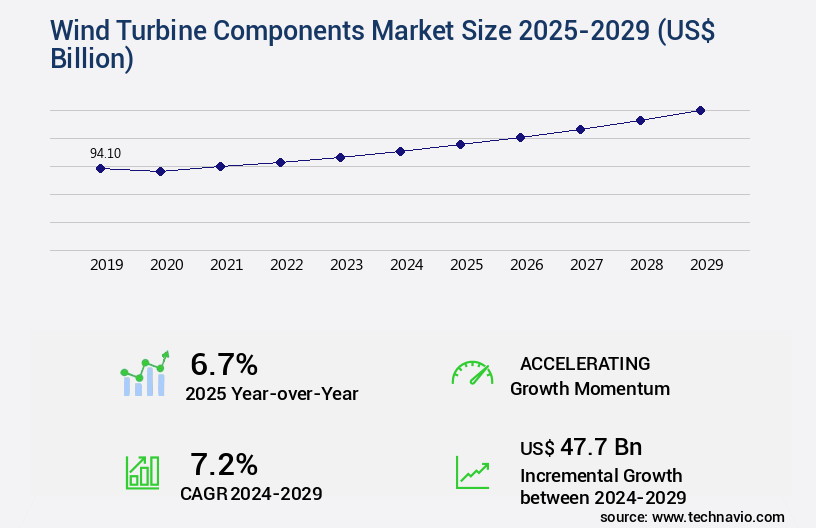
Get Key Insights on Market Forecast (PDF) Request Free Sample
How is the Wind Turbine Components Market Segmented and what are the key trends of market segmentation?
The wind turbine components industry research report provides comprehensive data (region-wise segment analysis), with forecasts and estimates in "USD billion" for the period 2025-2029, as well as historical data from 2019-2023 for the following segments.
- Application
- Product
- Wind turbine rotor blades
- Wind turbine gearboxes
- Wind turbine generators
- Wind turbine towers
- Others
- Geography
- North America
- Europe
- APAC
- South America
- Rest of World (ROW)
By Application Insights
The onshore segment is estimated to witness significant growth during the forecast period.
Onshore wind power plants, situated on land, have been gaining significant traction in the global energy market due to their cost-competitiveness against traditional fossil fuels like coal and natural gas. In countries such as the UK and China, the adoption of onshore wind power has seen a notable increase, driven by the decreasing cost of technology and finance. The onshore the market is witnessing continuous growth, with several innovations and advancements contributing to its expansion. For example, Vestas, a leading wind turbine manufacturer, has introduced a 4 megawatts (MW) platform, enabling onshore turbines to operate efficiently in a wide range of wind conditions.
Key components of wind turbines, including rotor diameter, corrosion protection, blade fatigue, material selection, hydraulic systems, wind turbine pitch, blade aerodynamics, thermal management, condition monitoring, and grid integration, are undergoing significant advancements. These improvements have led to increased energy yield and enhanced turbine performance. Moreover, the market is witnessing a growing focus on safety systems, blade manufacturing, capacity factor, vibration monitoring, yaw drive systems, foundation design, and tower assembly. The integration of advanced drivetrain technology, turbine lifespan extension, and maintenance schedules are also crucial factors influencing market growth. According to recent industry reports, the onshore the market is expected to grow by approximately 15% in the next two years, with a similar expansion rate forecasted for the following period.
This growth can be attributed to the increasing demand for renewable energy, advancements in technology, and government initiatives promoting the adoption of wind power. Furthermore, the market is witnessing a shift towards larger turbines with higher hub heights, which can generate more electricity from the same wind resource. This trend is expected to continue, as wind turbine manufacturers strive to maximize energy production and minimize operational costs. In conclusion, the onshore the market is experiencing robust growth, driven by technological advancements, cost competitiveness, and government initiatives. The market's continuous evolution is set to bring about significant improvements in energy yield, turbine performance, and overall efficiency.
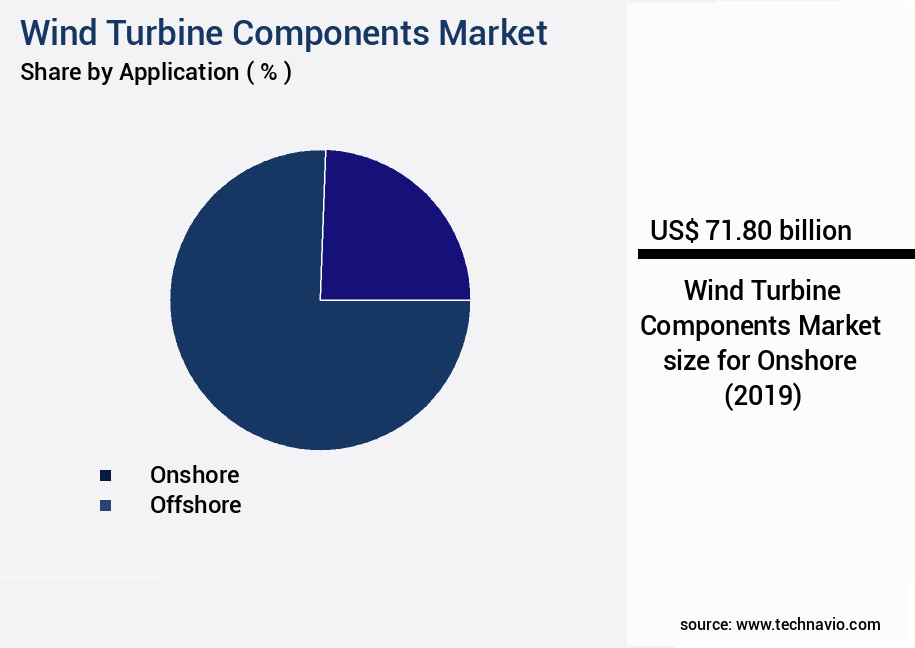
Request Free Sample
The Onshore segment was valued at USD 71.80 billion in 2019 and showed a gradual increase during the forecast period.
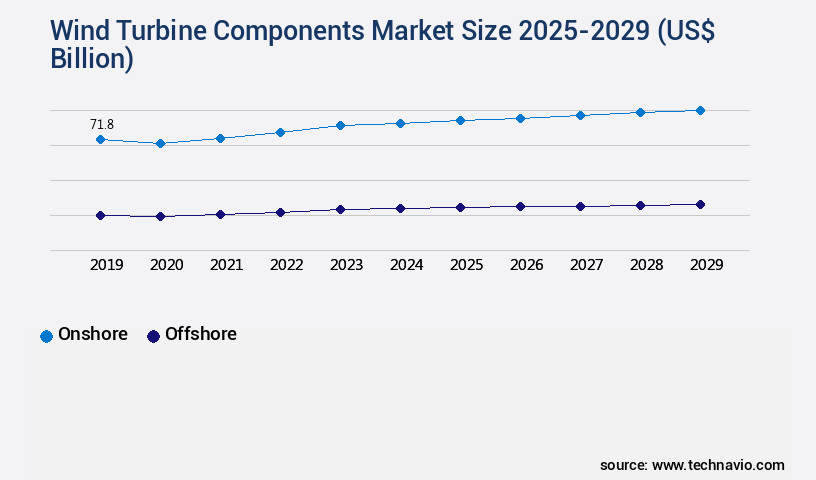
Request Free Sample
Regional Analysis
APAC is estimated to contribute 39% to the growth of the global market during the forecast period.Technavio’s analysts have elaborately explained the regional trends and drivers that shape the market during the forecast period.
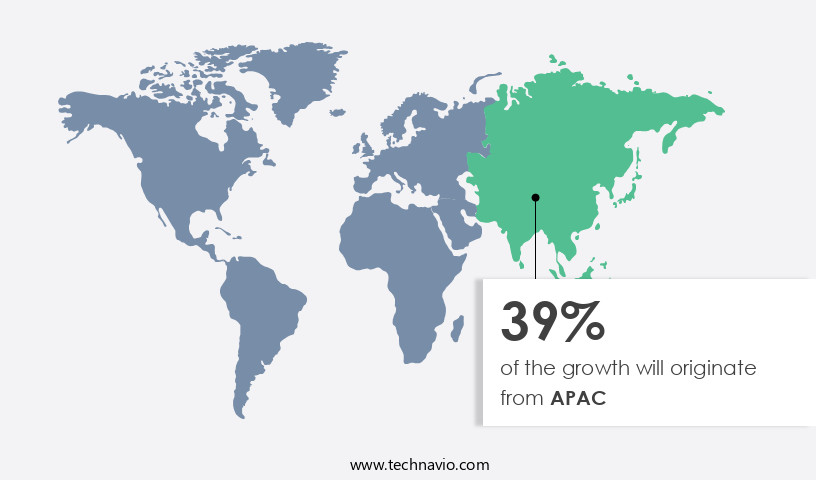
See How Wind Turbine Components Market Demand is Rising in APAC Request Free Sample
The Asia-Pacific (APAC) region holds a significant position in The market, accounting for over 40% of the market share in 2023. This dominance is fueled by the increasing demand for renewable energy sources, supportive government initiatives, and the presence of major players such as Vestas Wind Systems A/S, Siemens Gamesa Renewable Energy, Suzlon Energy Limited, and Goldwind. However, challenges persist, with state grids in China encountering transmission bottlenecks and the Indian government transitioning from feed-in-tariffs (FiTs) to competitive auctions, creating a policy gap that necessitates stakeholder adjustments.
Despite these hurdles, the APAC region's the market is poised for continued growth, driven by the region's commitment to renewable energy and ongoing industry developments.
Market Dynamics
Our researchers analyzed the data with 2024 as the base year, along with the key drivers, trends, and challenges. A holistic analysis of drivers will help companies refine their marketing strategies to gain a competitive advantage.
The market is witnessing significant growth due to the increasing emphasis on optimizing wind turbine performance and reducing operational expenses for wind farms. Advanced blade designs are being adopted to enhance energy capture, with manufacturers focusing on aerodynamic efficiency and lightweight materials. Innovative tower construction techniques, such as lattice towers and concrete towers, are being employed to improve generator efficiency through advanced cooling systems and nacelle system integration and reliability. Predictive maintenance strategies for wind turbine components are gaining traction, with the adoption of advanced sensor technology for enhanced condition monitoring and structural analysis techniques for wind turbine design.
The impact of wind resource variability and climate conditions on turbine performance is being mitigated through the implementation of advanced control algorithms for wind turbine energy maximization and designing resilient wind turbine foundations. More than 70% of new product developments in the wind turbine industry focus on improving safety and reliability, reducing maintenance costs, and minimizing wind turbine downtime. The industrial application segment accounts for a significantly larger share of the market compared to the academic segment, with the former prioritizing efficiency and cost savings. Efficient blade manufacturing techniques, such as 3D printing and composite materials, are being employed to reduce operational expenses for wind farms.
The effect of different tower heights on energy production is under investigation, with taller towers offering increased capacity but higher construction costs. The implementation of advanced grid integration strategies is also a key trend, enabling the seamless integration of wind energy into power grids and improving the overall efficiency of the renewable energy sector.
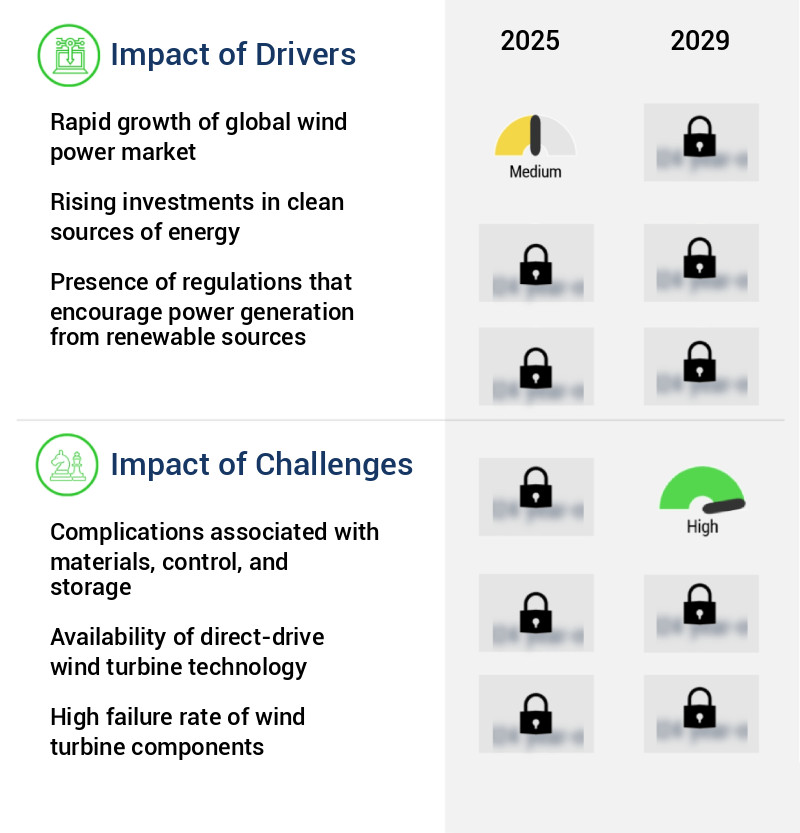
What are the key market drivers leading to the rise in the adoption of Wind Turbine Components Industry?
- The expansion of the global wind power market is the primary catalyst, driving significant growth in this sector.
- The global wind power market is experiencing significant growth, primarily fueled by Europe and China, with Europe accounting for approximately 40% of the total installations and China contributing around 35% in 2025. The wind power sector's expansion is attributed to advancements in technology, specifically in the onshore and offshore sectors. Onshore wind development has seen substantial growth due to the integration of advanced electronics and efficient planning and management, resulting in enhanced reliability and cost reduction. Notably, the onshore sector's capacity has grown to support wind turbines with capacities exceeding 5 MW. In the offshore sector, technological advancements have made large-scale projects viable, with turbines now capable of supporting over 1 MW.
- For instance, in late 2025, ScottishPower signed a 1 billion pound deal with Siemens Gamesa to procure 64 SG 14-236 DD offshore wind turbines for the East Anglia TWO offshore wind farm. This collaboration underscores the market's continuous evolution and the increasing importance of wind power in the global energy landscape.
What are the market trends shaping the Wind Turbine Components Industry?
- The cost of wind power is consistently declining and represents an emerging market trend.
- Wind power, fueled by technological advancements, has emerged as a significant contributor to the global electricity generation landscape. With economies of scale coming into play, wind is poised to become the most cost-effective energy source in numerous regions. The System Management of Atmospheric Resource through Technology (SMART) strategy, an innovative approach, will propel next-generation wind power plants to deliver consistent and efficient energy production for extended periods. This strategy encompasses four key areas of innovation: high-fidelity physics modeling to predict performance based on local conditions, real-time wind flow monitoring using sensors for enhanced control, adoption of advanced rotor and drivetrain technologies, and direct communication between turbines and the grid.
- These advancements underscore the dynamic nature of the wind power market and its expanding applications across various sectors.
What challenges does the Wind Turbine Components Industry face during its growth?
- The complexities related to material selection, process control, and storage management pose significant challenges to the industry's growth trajectory.
- The market encounters complexities in materials, control, and energy storage, posing substantial challenges for the industry. The diversity of renewable energy resources, including wind, solar, and hydro, necessitates the creation of customized components and systems to optimally exploit these resources. Moreover, the efficient control and storage of generated energy are crucial, as it must be effectively managed and distributed to cater to the escalating demand for renewable energy.
- The market grapples with the requirement for advanced materials and technologies to enhance wind turbine efficiency and dependability. Furthermore, the development of effective energy storage solutions is essential to ensure a steady and consistent energy supply.
Exclusive Technavio Analysis on Customer Landscape
The wind turbine components market forecasting report includes the adoption lifecycle of the market, covering from the innovator’s stage to the laggard’s stage. It focuses on adoption rates in different regions based on penetration. Furthermore, the wind turbine components market report also includes key purchase criteria and drivers of price sensitivity to help companies evaluate and develop their market growth analysis strategies.
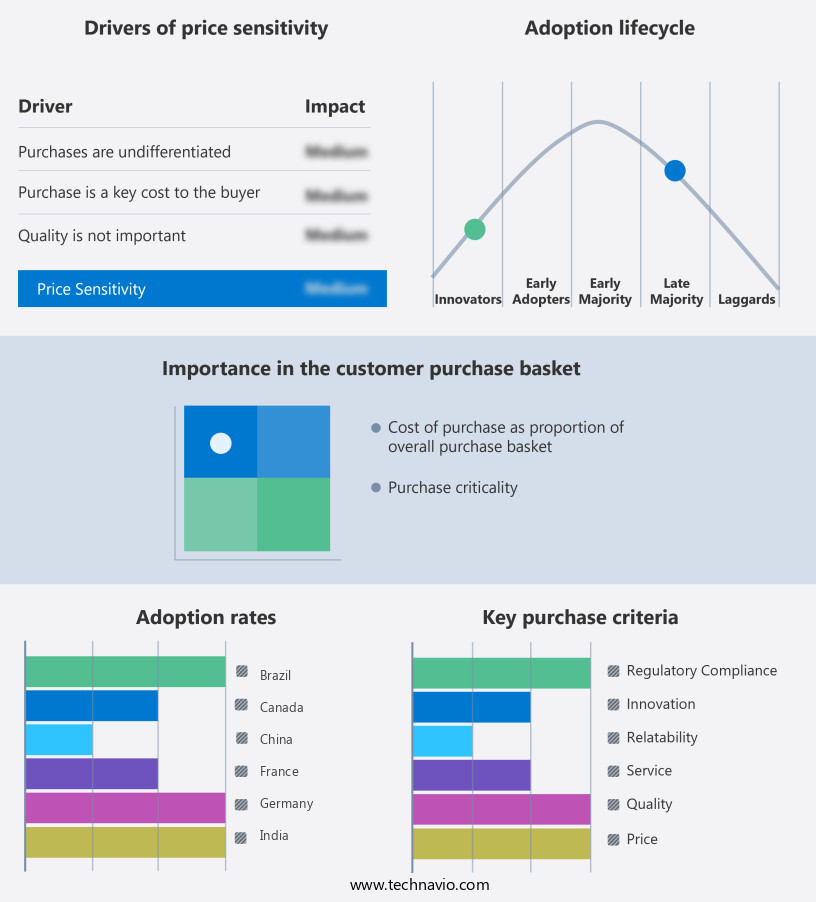
Customer Landscape of Wind Turbine Components Industry
Competitive Landscape
Companies are implementing various strategies, such as strategic alliances, wind turbine components market forecast, partnerships, mergers and acquisitions, geographical expansion, and product/service launches, to enhance their presence in the industry.
CS WIND Corp. - This company specializes in manufacturing and supplying wind turbine components, including onshore wind towers, for the global renewable energy sector. Their offerings contribute to the industry's growth by enhancing wind energy efficiency and sustainability.
The industry research and growth report includes detailed analyses of the competitive landscape of the market and information about key companies, including:
- CS WIND Corp.
- Dongfang Electric Wind Power Co. Ltd.
- Emergya Wind Technologies BV
- EnBW Energie Baden Wurttemberg AG
- ENERCON GmbH
- Envision Group
- Flender GmbH
- GE Vernova Inc.
- ISHIBASHI Manufacturing Co. Ltd.
- Max Bogl Wind AG
- Ming Yang Smart Energy Group Ltd.
- Nanjing High Speed Gear Manufacturing Co. Ltd.
- Siemens Gamesa Renewable Energy SA
- Sinoma Science and Technology Co. Ltd.
- Suzlon Energy Ltd.
- TPI Composites Inc.
- Vestas Wind Systems AS
- XEMC Darwind BV
- Xinjiang Goldwind Science and Technology Co. Ltd.
- ZF Friedrichshafen AG
Qualitative and quantitative analysis of companies has been conducted to help clients understand the wider business environment as well as the strengths and weaknesses of key industry players. Data is qualitatively analyzed to categorize companies as pure play, category-focused, industry-focused, and diversified; it is quantitatively analyzed to categorize companies as dominant, leading, strong, tentative, and weak.
Recent Development and News in Wind Turbine Components Market
- In January 2024, Vestas Wind Systems A/S, a leading wind turbine manufacturer, announced the launch of its new V160-0.6 MW wind turbine, featuring the largest rotor in the industry and a significant increase in power capacity (Vestas press release).
- In March 2024, Siemens Gamesa Renewable Energy and General Electric Renewable Energy entered into a strategic partnership to collaborate on offshore wind projects, combining their expertise in technology and project development (Siemens Gamesa press release).
- In May 2024, Nordex SE secured a €300 million (USD333 million) investment from the European Investment Bank to support the production and installation of wind turbines in Europe, marking a significant boost for the company's growth (European Investment Bank press release).
- In April 2025, the US Department of Energy announced the approval of the largest wind energy project in the country, the 3 GW Chisholm View Wind Project in Texas, which will create substantial demand for wind turbine components (US Department of Energy press release).
Dive into Technavio’s robust research methodology, blending expert interviews, extensive data synthesis, and validated models for unparalleled Wind Turbine Components Market insights. See full methodology.
|
Market Scope
|
|
Report Coverage
|
Details
|
|
Page number
|
201
|
|
Base year
|
2024
|
|
Historic period
|
2019-2023 |
|
Forecast period
|
2025-2029
|
|
Growth momentum & CAGR
|
Accelerate at a CAGR of 7.2%
|
|
Market growth 2025-2029
|
USD 47.7 billion
|
|
Market structure
|
Fragmented
|
|
YoY growth 2024-2025(%)
|
6.7
|
|
Key countries
|
US, China, India, Germany, Japan, Spain, UK, Canada, France, and Brazil
|
|
Competitive landscape
|
Leading Companies, Market Positioning of Companies, Competitive Strategies, and Industry Risks
|
Request Free Sample
Research Analyst Overview
- In the dynamic and evolving wind energy sector, components of wind turbines continue to garner significant attention. Rotor diameters have expanded, reaching impressive sizes to maximize energy yield. Corrosion protection technologies have advanced to ensure longevity in harsh environments. Failure analysis and structural assessment play crucial roles in enhancing turbine performance and reliability. Hydraulic systems have been optimized for efficiency, while wind turbine pitch systems enable optimal energy capture. Blade fatigue and blade aerodynamics are subjects of ongoing research to improve energy yield and reduce maintenance costs. Material selection and thermal management are essential aspects of wind turbine design, with advanced materials and cooling systems contributing to increased capacity factors and generator efficiency.
- Condition monitoring and grid integration technologies have emerged as essential components, ensuring optimal turbine performance and efficient energy transfer. Nacelle design, safety systems, and yaw drive systems have evolved to improve turbine efficiency and reduce downtime. Foundation design and tower assembly have become more robust to accommodate larger turbines and harsher conditions. Drivetrain technology advancements have led to longer turbine lifespans and reduced maintenance schedules. Vibration monitoring and gearbox maintenance are critical aspects of turbine operation, with innovative solutions enabling predictive maintenance and reducing downtime. Blade manufacturing processes have been refined to improve blade durability and reduce costs.
- Power curve optimization and turbine control systems have become increasingly sophisticated, enabling improved energy yield and grid stability. Overall, the market is characterized by continuous innovation and evolution, with a focus on enhancing efficiency, reliability, and cost-effectiveness.
What are the Key Data Covered in this Wind Turbine Components Market Research and Growth Report?
-
What is the expected growth of the Wind Turbine Components Market between 2025 and 2029?
-
What segmentation does the market report cover?
-
The report segmented by Application (Onshore and Offshore), Product (Wind turbine rotor blades, Wind turbine gearboxes, Wind turbine generators, Wind turbine towers, and Others), and Geography (APAC, Europe, North America, South America, and Middle East and Africa)
-
Which regions are analyzed in the report?
-
APAC, Europe, North America, South America, and Middle East and Africa
-
What are the key growth drivers and market challenges?
-
Rapid growth of global wind power market, Complications associated with materials, control, and storage
-
Who are the major players in the Wind Turbine Components Market?
-
Key Companies CS WIND Corp., Dongfang Electric Wind Power Co. Ltd., Emergya Wind Technologies BV, EnBW Energie Baden Wurttemberg AG, ENERCON GmbH, Envision Group, Flender GmbH, GE Vernova Inc., ISHIBASHI Manufacturing Co. Ltd., Max Bogl Wind AG, Ming Yang Smart Energy Group Ltd., Nanjing High Speed Gear Manufacturing Co. Ltd., Siemens Gamesa Renewable Energy SA, Sinoma Science and Technology Co. Ltd., Suzlon Energy Ltd., TPI Composites Inc., Vestas Wind Systems AS, XEMC Darwind BV, Xinjiang Goldwind Science and Technology Co. Ltd., and ZF Friedrichshafen AG
Market Research Insights
- The market encompasses a diverse range of technologies and materials essential to optimizing energy production from wind sources. Two key aspects of this market are the continuous advancements in control algorithms and sensor technology, which enhance component reliability and reduce maintenance costs. For instance, the use of predictive maintenance and fault detection systems can increase a wind farm's load factor by up to 5%, translating to significant energy savings and revenue gains. Moreover, the selection of appropriate materials, such as composite materials for blades and hydraulic fluids for gearboxes, plays a crucial role in improving component durability and efficiency.
- For example, a wind turbine with high-performance composite blades can yield a rated power output increase of up to 10% compared to traditional materials. The integration of energy storage systems and advanced power electronics further enhances the overall system's performance and adaptability to varying wind conditions. In summary, the market is characterized by ongoing innovation in areas like control algorithms, sensor technology, material selection, and energy storage, enabling enhanced energy production, improved component reliability, and reduced maintenance costs.
We can help! Our analysts can customize this wind turbine components market research report to meet your requirements.
Get in touch
1 Executive Summary
- 1.1 Market overview
- Executive Summary - Chart on Market Overview
- Executive Summary - Data Table on Market Overview
- Executive Summary - Chart on Global Market Characteristics
- Executive Summary - Chart on Market by Geography
- Executive Summary - Chart on Market Segmentation by Application
- Executive Summary - Chart on Market Segmentation by Product
- Executive Summary - Chart on Incremental Growth
- Executive Summary - Data Table on Incremental Growth
- Executive Summary - Chart on Company Market Positioning
2 Technavio Analysis
- 2.1 Analysis of price sensitivity, lifecycle, customer purchase basket, adoption rates, and purchase criteria
- Analysis of price sensitivity, lifecycle, customer purchase basket, adoption rates, and purchase criteria
- 2.2 Criticality of inputs and Factors of differentiation
- Overview on criticality of inputs and factors of differentiation
- 2.3 Factors of disruption
- Overview on factors of disruption
- 2.4 Impact of drivers and challenges
- Impact of drivers and challenges in 2024 and 2029
3 Market Landscape
- 3.1 Market ecosystem
- Parent Market
- Data Table on - Parent Market
- 3.2 Market characteristics
- Market characteristics analysis
4 Market Sizing
- 4.1 Market definition
- Offerings of companies included in the market definition
- 4.2 Market segment analysis
- 4.4 Market outlook: Forecast for 2024-2029
- Chart on Global - Market size and forecast 2024-2029 ($ billion)
- Data Table on Global - Market size and forecast 2024-2029 ($ billion)
- Chart on Global Market: Year-over-year growth 2024-2029 (%)
- Data Table on Global Market: Year-over-year growth 2024-2029 (%)
5 Historic Market Size
- 5.1 Global Wind Turbine Components Market 2019 - 2023
- Historic Market Size - Data Table on Global Wind Turbine Components Market 2019 - 2023 ($ billion)
- 5.2 Application segment analysis 2019 - 2023
- Historic Market Size - Application Segment 2019 - 2023 ($ billion)
- 5.3 Product segment analysis 2019 - 2023
- Historic Market Size - Product Segment 2019 - 2023 ($ billion)
- 5.4 Geography segment analysis 2019 - 2023
- Historic Market Size - Geography Segment 2019 - 2023 ($ billion)
- 5.5 Country segment analysis 2019 - 2023
- Historic Market Size - Country Segment 2019 - 2023 ($ billion)
6 Qualitative Analysis
- 6.1 Impact of AI on Global Wind Turbine Components Market
7 Five Forces Analysis
- 7.1 Five forces summary
- Five forces analysis - Comparison between 2024 and 2029
- 7.2 Bargaining power of buyers
- Bargaining power of buyers - Impact of key factors 2024 and 2029
- 7.3 Bargaining power of suppliers
- Bargaining power of suppliers - Impact of key factors in 2024 and 2029
- 7.4 Threat of new entrants
- Threat of new entrants - Impact of key factors in 2024 and 2029
- 7.5 Threat of substitutes
- Threat of substitutes - Impact of key factors in 2024 and 2029
- 7.6 Threat of rivalry
- Threat of rivalry - Impact of key factors in 2024 and 2029
- 7.7 Market condition
- Chart on Market condition - Five forces 2024 and 2029
8 Market Segmentation by Application
- 8.1 Market segments
- Chart on Application - Market share 2024-2029 (%)
- Data Table on Application - Market share 2024-2029 (%)
- 8.2 Comparison by Application
- Chart on Comparison by Application
- Data Table on Comparison by Application
- 8.3 Onshore - Market size and forecast 2024-2029
- Chart on Onshore - Market size and forecast 2024-2029 ($ billion)
- Data Table on Onshore - Market size and forecast 2024-2029 ($ billion)
- Chart on Onshore - Year-over-year growth 2024-2029 (%)
- Data Table on Onshore - Year-over-year growth 2024-2029 (%)
- 8.4 Offshore - Market size and forecast 2024-2029
- Chart on Offshore - Market size and forecast 2024-2029 ($ billion)
- Data Table on Offshore - Market size and forecast 2024-2029 ($ billion)
- Chart on Offshore - Year-over-year growth 2024-2029 (%)
- Data Table on Offshore - Year-over-year growth 2024-2029 (%)
- 8.5 Market opportunity by Application
- Market opportunity by Application ($ billion)
- Data Table on Market opportunity by Application ($ billion)
9 Market Segmentation by Product
- 9.1 Market segments
- Chart on Product - Market share 2024-2029 (%)
- Data Table on Product - Market share 2024-2029 (%)
- 9.2 Comparison by Product
- Chart on Comparison by Product
- Data Table on Comparison by Product
- 9.3 Wind turbine rotor blades - Market size and forecast 2024-2029
- Chart on Wind turbine rotor blades - Market size and forecast 2024-2029 ($ billion)
- Data Table on Wind turbine rotor blades - Market size and forecast 2024-2029 ($ billion)
- Chart on Wind turbine rotor blades - Year-over-year growth 2024-2029 (%)
- Data Table on Wind turbine rotor blades - Year-over-year growth 2024-2029 (%)
- 9.4 Wind turbine gearboxes - Market size and forecast 2024-2029
- Chart on Wind turbine gearboxes - Market size and forecast 2024-2029 ($ billion)
- Data Table on Wind turbine gearboxes - Market size and forecast 2024-2029 ($ billion)
- Chart on Wind turbine gearboxes - Year-over-year growth 2024-2029 (%)
- Data Table on Wind turbine gearboxes - Year-over-year growth 2024-2029 (%)
- 9.5 Wind turbine generators - Market size and forecast 2024-2029
- Chart on Wind turbine generators - Market size and forecast 2024-2029 ($ billion)
- Data Table on Wind turbine generators - Market size and forecast 2024-2029 ($ billion)
- Chart on Wind turbine generators - Year-over-year growth 2024-2029 (%)
- Data Table on Wind turbine generators - Year-over-year growth 2024-2029 (%)
- 9.6 Wind turbine towers - Market size and forecast 2024-2029
- Chart on Wind turbine towers - Market size and forecast 2024-2029 ($ billion)
- Data Table on Wind turbine towers - Market size and forecast 2024-2029 ($ billion)
- Chart on Wind turbine towers - Year-over-year growth 2024-2029 (%)
- Data Table on Wind turbine towers - Year-over-year growth 2024-2029 (%)
- 9.7 Others - Market size and forecast 2024-2029
- Chart on Others - Market size and forecast 2024-2029 ($ billion)
- Data Table on Others - Market size and forecast 2024-2029 ($ billion)
- Chart on Others - Year-over-year growth 2024-2029 (%)
- Data Table on Others - Year-over-year growth 2024-2029 (%)
- 9.8 Market opportunity by Product
- Market opportunity by Product ($ billion)
- Data Table on Market opportunity by Product ($ billion)
10 Customer Landscape
- 10.1 Customer landscape overview
- Analysis of price sensitivity, lifecycle, customer purchase basket, adoption rates, and purchase criteria
11 Geographic Landscape
- 11.1 Geographic segmentation
- Chart on Market share by geography 2024-2029 (%)
- Data Table on Market share by geography 2024-2029 (%)
- 11.2 Geographic comparison
- Chart on Geographic comparison
- Data Table on Geographic comparison
- 11.3 APAC - Market size and forecast 2024-2029
- Chart on APAC - Market size and forecast 2024-2029 ($ billion)
- Data Table on APAC - Market size and forecast 2024-2029 ($ billion)
- Chart on APAC - Year-over-year growth 2024-2029 (%)
- Data Table on APAC - Year-over-year growth 2024-2029 (%)
- 11.4 Europe - Market size and forecast 2024-2029
- Chart on Europe - Market size and forecast 2024-2029 ($ billion)
- Data Table on Europe - Market size and forecast 2024-2029 ($ billion)
- Chart on Europe - Year-over-year growth 2024-2029 (%)
- Data Table on Europe - Year-over-year growth 2024-2029 (%)
- 11.5 North America - Market size and forecast 2024-2029
- Chart on North America - Market size and forecast 2024-2029 ($ billion)
- Data Table on North America - Market size and forecast 2024-2029 ($ billion)
- Chart on North America - Year-over-year growth 2024-2029 (%)
- Data Table on North America - Year-over-year growth 2024-2029 (%)
- 11.6 South America - Market size and forecast 2024-2029
- Chart on South America - Market size and forecast 2024-2029 ($ billion)
- Data Table on South America - Market size and forecast 2024-2029 ($ billion)
- Chart on South America - Year-over-year growth 2024-2029 (%)
- Data Table on South America - Year-over-year growth 2024-2029 (%)
- 11.7 Middle East and Africa - Market size and forecast 2024-2029
- Chart on Middle East and Africa - Market size and forecast 2024-2029 ($ billion)
- Data Table on Middle East and Africa - Market size and forecast 2024-2029 ($ billion)
- Chart on Middle East and Africa - Year-over-year growth 2024-2029 (%)
- Data Table on Middle East and Africa - Year-over-year growth 2024-2029 (%)
- 11.8 US - Market size and forecast 2024-2029
- Chart on US - Market size and forecast 2024-2029 ($ billion)
- Data Table on US - Market size and forecast 2024-2029 ($ billion)
- Chart on US - Year-over-year growth 2024-2029 (%)
- Data Table on US - Year-over-year growth 2024-2029 (%)
- 11.9 China - Market size and forecast 2024-2029
- Chart on China - Market size and forecast 2024-2029 ($ billion)
- Data Table on China - Market size and forecast 2024-2029 ($ billion)
- Chart on China - Year-over-year growth 2024-2029 (%)
- Data Table on China - Year-over-year growth 2024-2029 (%)
- 11.10 India - Market size and forecast 2024-2029
- Chart on India - Market size and forecast 2024-2029 ($ billion)
- Data Table on India - Market size and forecast 2024-2029 ($ billion)
- Chart on India - Year-over-year growth 2024-2029 (%)
- Data Table on India - Year-over-year growth 2024-2029 (%)
- 11.11 Germany - Market size and forecast 2024-2029
- Chart on Germany - Market size and forecast 2024-2029 ($ billion)
- Data Table on Germany - Market size and forecast 2024-2029 ($ billion)
- Chart on Germany - Year-over-year growth 2024-2029 (%)
- Data Table on Germany - Year-over-year growth 2024-2029 (%)
- 11.12 Japan - Market size and forecast 2024-2029
- Chart on Japan - Market size and forecast 2024-2029 ($ billion)
- Data Table on Japan - Market size and forecast 2024-2029 ($ billion)
- Chart on Japan - Year-over-year growth 2024-2029 (%)
- Data Table on Japan - Year-over-year growth 2024-2029 (%)
- 11.13 Spain - Market size and forecast 2024-2029
- Chart on Spain - Market size and forecast 2024-2029 ($ billion)
- Data Table on Spain - Market size and forecast 2024-2029 ($ billion)
- Chart on Spain - Year-over-year growth 2024-2029 (%)
- Data Table on Spain - Year-over-year growth 2024-2029 (%)
- 11.14 UK - Market size and forecast 2024-2029
- Chart on UK - Market size and forecast 2024-2029 ($ billion)
- Data Table on UK - Market size and forecast 2024-2029 ($ billion)
- Chart on UK - Year-over-year growth 2024-2029 (%)
- Data Table on UK - Year-over-year growth 2024-2029 (%)
- 11.15 Canada - Market size and forecast 2024-2029
- Chart on Canada - Market size and forecast 2024-2029 ($ billion)
- Data Table on Canada - Market size and forecast 2024-2029 ($ billion)
- Chart on Canada - Year-over-year growth 2024-2029 (%)
- Data Table on Canada - Year-over-year growth 2024-2029 (%)
- 11.16 France - Market size and forecast 2024-2029
- Chart on France - Market size and forecast 2024-2029 ($ billion)
- Data Table on France - Market size and forecast 2024-2029 ($ billion)
- Chart on France - Year-over-year growth 2024-2029 (%)
- Data Table on France - Year-over-year growth 2024-2029 (%)
- 11.17 Brazil - Market size and forecast 2024-2029
- Chart on Brazil - Market size and forecast 2024-2029 ($ billion)
- Data Table on Brazil - Market size and forecast 2024-2029 ($ billion)
- Chart on Brazil - Year-over-year growth 2024-2029 (%)
- Data Table on Brazil - Year-over-year growth 2024-2029 (%)
- 11.18 Market opportunity by geography
- Market opportunity by geography ($ billion)
- Data Tables on Market opportunity by geography ($ billion)
12 Drivers, Challenges, and Opportunity/Restraints
- 12.3 Impact of drivers and challenges
- Impact of drivers and challenges in 2024 and 2029
- 12.4 Market opportunities/restraints
13 Competitive Landscape
- 13.2 Competitive Landscape
- Overview on criticality of inputs and factors of differentiation
- 13.3 Landscape disruption
- Overview on factors of disruption
- 13.4 Industry risks
- Impact of key risks on business
14 Competitive Analysis
- 14.2 Company ranking index
- 14.3 Market positioning of companies
- Matrix on companies position and classification
- 14.4 CS WIND Corp.
- CS WIND Corp. - Overview
- CS WIND Corp. - Product / Service
- CS WIND Corp. - Key offerings
- SWOT
- 14.5 Dongfang Electric Wind Power Co. Ltd.
- Dongfang Electric Wind Power Co. Ltd. - Overview
- Dongfang Electric Wind Power Co. Ltd. - Product / Service
- Dongfang Electric Wind Power Co. Ltd. - Key news
- Dongfang Electric Wind Power Co. Ltd. - Key offerings
- SWOT
- 14.6 Emergya Wind Technologies BV
- Emergya Wind Technologies BV - Overview
- Emergya Wind Technologies BV - Product / Service
- Emergya Wind Technologies BV - Key offerings
- SWOT
- 14.7 EnBW Energie Baden Wurttemberg AG
- EnBW Energie Baden Wurttemberg AG - Overview
- EnBW Energie Baden Wurttemberg AG - Business segments
- EnBW Energie Baden Wurttemberg AG - Key offerings
- EnBW Energie Baden Wurttemberg AG - Segment focus
- SWOT
- 14.8 ENERCON GmbH
- ENERCON GmbH - Overview
- ENERCON GmbH - Product / Service
- ENERCON GmbH - Key offerings
- SWOT
- 14.9 Envision Group
- Envision Group - Overview
- Envision Group - Product / Service
- Envision Group - Key offerings
- SWOT
- 14.10 Flender GmbH
- Flender GmbH - Overview
- Flender GmbH - Product / Service
- Flender GmbH - Key offerings
- SWOT
- 14.11 GE Vernova Inc.
- GE Vernova Inc. - Overview
- GE Vernova Inc. - Product / Service
- GE Vernova Inc. - Key news
- GE Vernova Inc. - Key offerings
- SWOT
- 14.12 ISHIBASHI Manufacturing Co. Ltd.
- ISHIBASHI Manufacturing Co. Ltd. - Overview
- ISHIBASHI Manufacturing Co. Ltd. - Product / Service
- ISHIBASHI Manufacturing Co. Ltd. - Key offerings
- SWOT
- 14.13 Max Bogl Wind AG
- Max Bogl Wind AG - Overview
- Max Bogl Wind AG - Product / Service
- Max Bogl Wind AG - Key offerings
- SWOT
- 14.14 Ming Yang Smart Energy Group Ltd.
- Ming Yang Smart Energy Group Ltd. - Overview
- Ming Yang Smart Energy Group Ltd. - Business segments
- Ming Yang Smart Energy Group Ltd. - Key offerings
- Ming Yang Smart Energy Group Ltd. - Segment focus
- SWOT
- 14.15 Nanjing High Speed Gear Manufacturing Co. Ltd.
- Nanjing High Speed Gear Manufacturing Co. Ltd. - Overview
- Nanjing High Speed Gear Manufacturing Co. Ltd. - Product / Service
- Nanjing High Speed Gear Manufacturing Co. Ltd. - Key offerings
- SWOT
- 14.16 Siemens Gamesa Renewable Energy SA
- Siemens Gamesa Renewable Energy SA - Overview
- Siemens Gamesa Renewable Energy SA - Product / Service
- Siemens Gamesa Renewable Energy SA - Key news
- Siemens Gamesa Renewable Energy SA - Key offerings
- SWOT
- 14.17 Sinoma Science and Technology Co. Ltd.
- Sinoma Science and Technology Co. Ltd. - Overview
- Sinoma Science and Technology Co. Ltd. - Product / Service
- Sinoma Science and Technology Co. Ltd. - Key offerings
- SWOT
- 14.18 Suzlon Energy Ltd.
- Suzlon Energy Ltd. - Overview
- Suzlon Energy Ltd. - Business segments
- Suzlon Energy Ltd. - Key offerings
- Suzlon Energy Ltd. - Segment focus
- SWOT
15 Appendix
- 15.2 Inclusions and exclusions checklist
- Inclusions checklist
- Exclusions checklist
- 15.3 Currency conversion rates for US$
- Currency conversion rates for US$
- 15.4 Research methodology
- 15.7 Validation techniques employed for market sizing
- Validation techniques employed for market sizing
- 15.9 360 degree market analysis
- 360 degree market analysis
- 15.10 List of abbreviations







![]() Get the report (PDF) sent to your email within minutes.
Get the report (PDF) sent to your email within minutes.
Complimentary full Excel data with your report purchase.